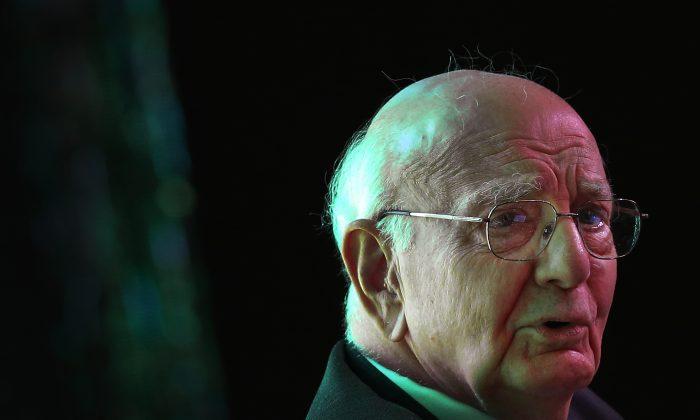NEW YORK—Paul Volcker is a living financial legend. As a chairman of the Federal Reserve in the early ′80s, he was singlehandedly responsible for quashing stagflation by raising interest rates to an unheard of 20 percent by June 1981.
What ensued was an unprecedented economic expansion and bull market in stocks, which was only seriously stopped by the Internet bust in 1999, caused by the lax monetary policy of Volcker’s successor Alan Greenspan.
As part of a meeting of the Committee for Monetary Research and Education, Volcker (88) gave us rare insights into his story, the working of the Fed, and current financial issues at the University Club in New York, on March 25.
Volcker served under both Democratic and Republican presidents but got along well with both.
“When I became chairman, we had pretty bad inflation. President Carter was under some pressure. He recognized inflation was a big problem and something had to be done about it,” he said.
Volcker had publicly said he would shake up the current workings of the Fed and raise interest rates, a move that usually reduces economic activity and costs votes.
“It must have made him a bit nervous to appoint this guy he never heard of and this guy is talking tough, but he thought he had the whole term to fix the problem,” Volcker said.
Indeed, the end of Carter’s term in 1981 saw the peak of inflation at a mind-boggling 13.5 percent, but it didn’t come down soon enough get him re-elected.
However, while the new President Reagan benefited from the Volcker reforms, not all Republicans in the White House were happy with him or the Federal Reserve.
“[Reagan] had all these Republican advisers who were all against the Federal Reserve and I was the only person to defend the Federal Reserve. At the end, President Reagan, to the best of my knowledge never publicly said anything bad against the Federal Reserve and our policies,” Volcker said.
Volcker also argued that the Fed and the White House should keep an appropriate distance for the Fed to remain independent of politics.
He himself only visited the White House once outside of his official calendar. This policy is different from current Fed officials but also from some of his predecessors.
“Arthur F. Burns was close to Nixon. He saw himself responsible for advising the White House. It’s hard to do that without the White House saying: ‘Well you give us a lot of advice; we think you could use some advice as well.’ It’s not a very healthy relationship. A bit of a distance is appropriate.”
Gold, the Enemy
When it comes to a hot topic of today’s investment world, Mr. Volcker always had a very strong view on gold.
“Gold was the enemy to me because that was a speculative vehicle while I was trying to hold the system together. [The speculators] were on the other side.”
Then and now, the gold price is viewed as the inverse price of the confidence in the system. If gold is high, it usually means something is amiss. In Volcker’s time, the high inflation and budget deficits of the 70s propelled gold from a low of $35 before 1970 to a high of $668 in 1980.
After Volcker got inflation under control and Reagan’s policies ushered in a period of economic growth, gold went down to a low of $260 in the early 2000s.
In recent times, inflation as well as an exponential rise in private and government debt across the world, as well as different financial crises boosted gold to a high of $1,826 in 2011.
Gold supporters like Ron Paul have also advocated the auditing of the Federal Reserve, because they want to know exactly how much gold lies in Fort Knox. Volcker thinks they are mistaken because it’s not the Fed who actually controls the gold.
“The Treasury holds the gold, not the Federal Reserve. The Treasury issues a gold certificate to the Fed. The paper gold is on deposit at the Federal Reserve. It belongs to the United States. If you say: ‘We want an audit of the gold stock, we want to go to Fort Knox and count the gold bars.’ That was a popular idea at that time, but the Treasury never did it. For all we know the bars don’t exist,” he said with a smirk.
Having raised interest rates to a higher level than any other Fed chairman, he was coy about the current Fed’s opportunity to raise rates.
“However, given the sensitivity of the market to every tiny little wiggle, are they going to be able to manage some tightening without the market overreacting? At this moment only baby steps are possible,” he said. He believes the financial markets could crash if the Fed even started talking about raising rates, although he thinks rates should be normalized soon.
“The quicker we get there, the better,” he said.





